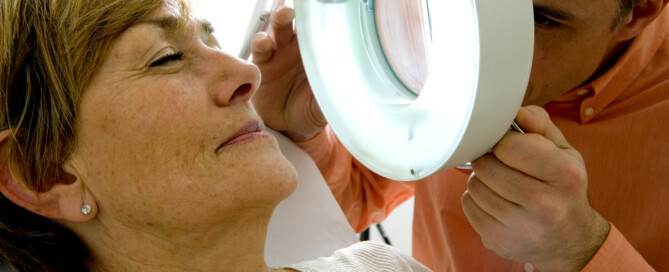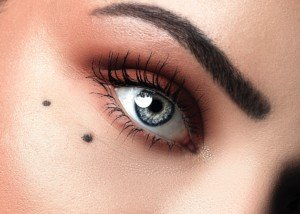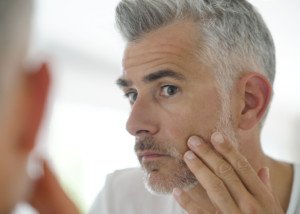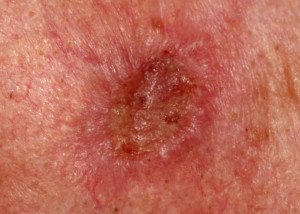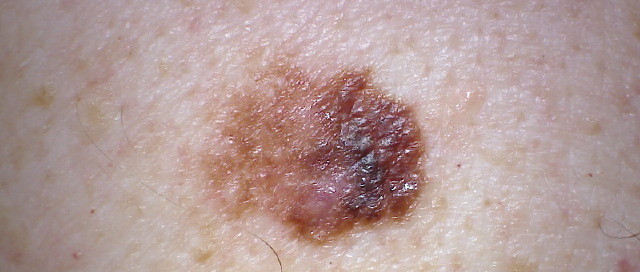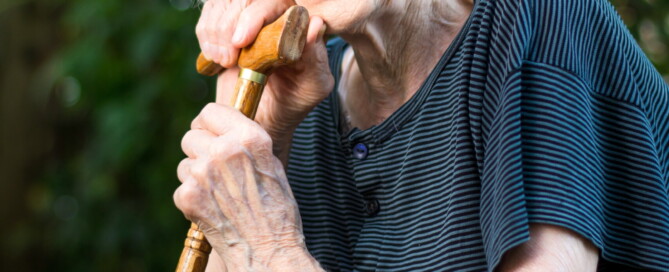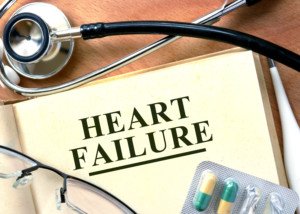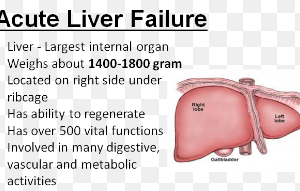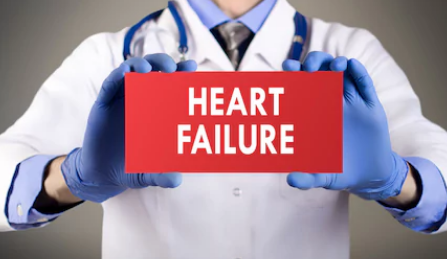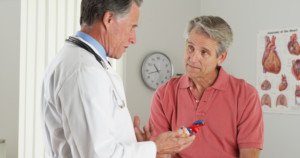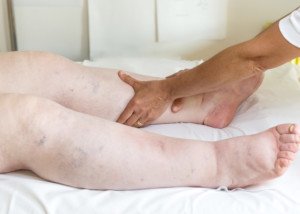Can a Benign Mole Get Bigger, Change Color and Shape?
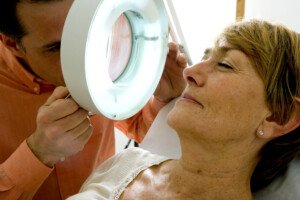
Warning signs for skin cancer include changing shape and colors in a pre-existing mole, as well as getting bigger.
However, can a benign mole undergo such changes?
I was motivated to write this article after seeing a photo of a large mole on a person’s back that was on a website for digital serial dermoscopy.
The serial images showed the mole changing and getting bigger in size, but the diagnosis ultimately was benign. This was quite surprising.
What a Doctor Says …
I then read a post in a thread about melanoma and moles, and the poster said that she had a mole that had become irregular in shape and multi-colored, but that the biopsy said it was benign.
- How can this be?
- Could a lab error be involved?
- How does a mole behave this way yet be benign?
- Let’s exclude some causes of changes in moles such as pregnancy and rubbing from clothes.
- I presented these questions to Dr. David Rahimi, MD, F.A.A.D., a board-certified dermatologist and cosmetic surgeon.
Dr. Rahimi explains, “Moles may change and still stay benign. Only a small percentage of moles in a predisposed person become malignant. Pathology could also have underestimated the degree of atypia.”
Atypia refers to cells that are not typical and thus more likely than typical cells to ever become cancerous.
If some of your moles have been identified as being atypical, you can always request that they be removed and biopsied for peace of mind, though sometimes a dermatologist will be the first to make this recommendation.

Dr. Rahimi is the founder of Forever Young, Inc.
 Lorra Garrick has been covering medical, fitness and cybersecurity topics for many years, having written thousands of articles for print magazines and websites, including as a ghostwriter. She’s also a former ACE-certified personal trainer.
Lorra Garrick has been covering medical, fitness and cybersecurity topics for many years, having written thousands of articles for print magazines and websites, including as a ghostwriter. She’s also a former ACE-certified personal trainer.
.
Top image: Shutterstock/Point Fr bigger change shape, color, benign
Skin Cancer on Scalp: Prevention Tips for Bald Men

Here is the bald man’s complete guide by a dermatologist on skin cancer prevention and detection on his scalp.
“Non-melanoma skin cancer is extremely common on the scalp in bald men,” says Dr. Joel Schlessinger, MD, board certified dermatologist and cosmetic surgeon with a private practice in Omaha, NE.
“Even melanoma is common there, and it is extremely important to guard against sun exposure if and when possible by wearing a hat (preferably brimmed) and sunscreen.”
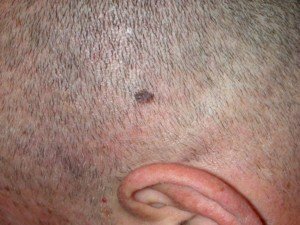
Melanoma
As a bald man, you may be hesitant to cover your pate when outdoors if this is the style you enjoy.
“Often the skin cancer can start off as a precancerous lesion called an actinic keratosis,” says Dr. Schlessinger.
A head full of actinic keratoses lesions is quite unsightly. Treatment for these red and pink, scaly splotches can leave scars.
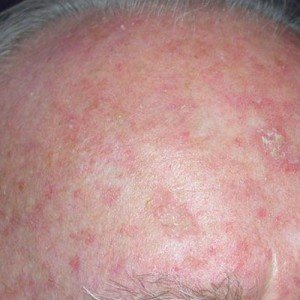
Actinic keratosis
But often, there’s no treatment because the bald man either doesn’t realize he has these lesions, or, he sees them but thinks they’re just a natural part of the skin’s aging process.
He may not even mind them that much, depending on how many or big they are.
But Dr. Schlessinger explains, “Over time it can progress to be a more significant issue, and if left untreated can develop into squamous cell carcinoma [a skin cancer].
“Other skin cancers such as basal cell carcinoma can also appear on the scalp.”
How often should bald men inspect their scalp?
“Men should inspect their scalp monthly if possible. If there is still hair present that makes it difficult, it’s possible to ask a hair stylist to take a look,” as part of the monthly routine. A partner or parent can also take a look.
Dr. Schlessinger continues, “If there are any suspicious areas they should be evaluated and possibly even biopsied.
“Skin cancers such as basal cell and squamous cell carcinoma tend to bleed if irritated, so that is a symptom to heed.
“Bald men should always apply sunscreen before leaving their home, but the important thing is that they should reapply every two hours while outside, so don’t leave home without a tube to replenish your sunscreen!
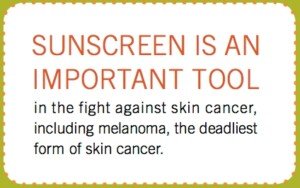
“Even on cloudy days there is sun and that sun will cause cancers if there is no protection.
“Hats are a perfect way to protect, but they should not be ball caps, as that way the ears are left out to the elements.
“A wide brimmed hat should be used to protect, rather than a ball cap for this reason.”
What is the most common cancer on the scalp of bald men?
“Generally, the squamous cell carcinoma is the most common form of skin cancer in bald men, but basal cell carcinoma is a close second,” says Dr. Schlessinger.
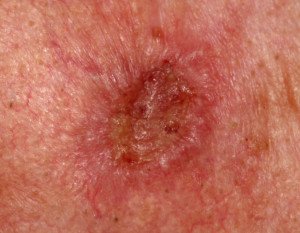
Squamous cell carscinoma. Shutterstock/Dermatology11
“Melanoma and a few less common skin cancers can also appear on the scalp.
“We are seeing an epidemic of skin cancer on the scalp as we see more sunlight and less protection from the ozone layer.
“The good news is that sunscreens are improving, but they need to be reapplied each 80 minutes if in water or sweating.
“Additionally, hats such as Tilley Hats, contain sun protection that will last for the entire duration of activities.”
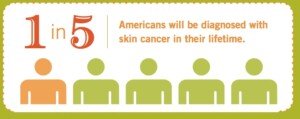
So if you’re part of the bald is beautiful camp, this means taking excellent care of your scalp to always be ahead (no pun intended) of skin cancer.
And by the way, these guidelines apply to men with darker skin.
 Dr. Schlessinger, founder of LovelySkin.com, has 25+ years of experience treating many skin conditions including melanoma. He’s founder of the Advanced Skin Research Center, a clinical facility that investigates new medications and treatments.
Dr. Schlessinger, founder of LovelySkin.com, has 25+ years of experience treating many skin conditions including melanoma. He’s founder of the Advanced Skin Research Center, a clinical facility that investigates new medications and treatments.
 Lorra Garrick has been covering medical, fitness and cybersecurity topics for many years, having written thousands of articles for print magazines and websites, including as a ghostwriter. She’s also a former ACE-certified personal trainer.
Lorra Garrick has been covering medical, fitness and cybersecurity topics for many years, having written thousands of articles for print magazines and websites, including as a ghostwriter. She’s also a former ACE-certified personal trainer.
.
Top image: Shutterstock/andrimka
Are Moles on Toes High Risk for Melanoma?
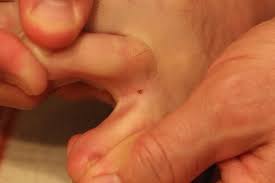
Many people assume that a mole on a toe is more likely to become melanoma, or, already is this deadly skin cancer.
“Moles on toes (and fingers) can be more concerning but aren’t usually melanomas,” says Dr. Joel Schlessinger, MD, a board certified dermatologist and cosmetic surgeon with a private practice in Omaha, NE.
“On the other hand (no pun intended!), they do tend to change more commonly and can turn into melanomas if they are exposed to the sun or tanning beds frequently.
“As a dermatologist, I always recommend my patients show me their hands and feet during a mole exam, as they can often be overlooked, especially when moles are between the webs of the toes.
“Anecdotally, I have seen a melanoma on the toe of an 18-year-old!
“It was caught when it was small enough that it wasn’t necessary to amputate, but if it had gotten much larger my patient would have lost his toe.”
What is meant by “they tend to change more commonly?”
“Moles on toes and fingers tend to be a little more likely to change from good to bad over time, so there is good reason to be concerned if one of these moles starts to turn darker over time,” says Dr. Schlessinger.
“Even those moles that are relatively ‘normal’ looking may be worthwhile showing to a dermatologist.
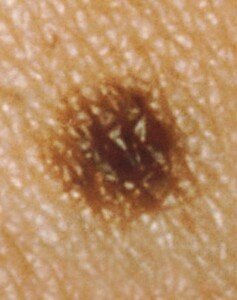
Common mole, 2 millimeters. Cancer.gov
“One of the reasons I suspect that moles on the hands and feet are bad actors is that people simply don’t examine these areas.
“For this reason, I always examine these areas when my patients come in for mole exams, even if my patients doubt there are any issues.
“It is shocking how many we find when we take the time to look!
“It is important to make sure your dermatologist takes the time to examine all areas of the body, including your hands and feet.
“Take off your shoes and socks if you are in the dermatologist’s office for a mole check.
“Also, make sure you lift up your feet so the dermatologist can examine them, and wiggle your toes so they reveal moles between the toes, if present.”
Prior to checking your feet, toes and between your toes for moles or any new spots, make sure that your feet, including between the toes, are thoroughly cleaned.
After all, a stubborn speck of dark debris can look very much like a suspicious mole.
 Dr. Schlessinger, founder of LovelySkin.com, has 25+ years of experience treating many skin conditions including melanoma. He’s founder of the Advanced Skin Research Center, a clinical facility that investigates new medications and treatments.
Dr. Schlessinger, founder of LovelySkin.com, has 25+ years of experience treating many skin conditions including melanoma. He’s founder of the Advanced Skin Research Center, a clinical facility that investigates new medications and treatments.
 Lorra Garrick has been covering medical, fitness and cybersecurity topics for many years, having written thousands of articles for print magazines and websites, including as a ghostwriter. She’s also a former ACE-certified personal trainer.
Lorra Garrick has been covering medical, fitness and cybersecurity topics for many years, having written thousands of articles for print magazines and websites, including as a ghostwriter. She’s also a former ACE-certified personal trainer.
Can Itching Be the ONLY Symptom of Melanoma?
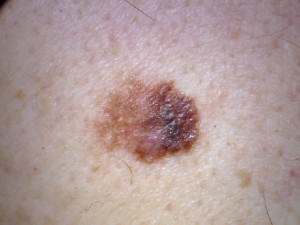
Perhaps you already know that an itching mole is a possible symptom of melanoma.
But what most medical sites do not say is whether or not this itching is almost always, or usually, or sometimes or rarely accompanied by other symptoms of a cancerous mole or lesion—such as crusting, bleeding, darkening or an increase in size.
“While itching is occasionally something that my patients relate as the symptom that brought them in for a mole or even a melanoma, it is very uncommon, actually,” says Dr. Joel Schlessinger, MD, a board certified dermatologist and cosmetic surgeon who has a private practice in Omaha, NE.
“That is why melanoma is so scary, as there can be no symptoms at all other than the changes in color. Moles, on the other hand, do tend to have times that they itch and even bleed.
“Interestingly, I have often seen patients who have presented with a very significant melanoma and they go so far as to state that they didn’t come in because it wasn’t itching ‘yet’.
“The important thing to remember here is that itch as a symptom that might be worth listening to is a very poor way to decide whether or not to see the dermatologist for a suspicious mole.
“While it may be a part of or reason to suspect that a mole is changing to be irritated, it doesn’t often correlate with the onset of a melanoma.”
If you suspect that a mole is itching, first be sure that it’s actually the spot that’s presenting with this symptom.
In other words, perhaps there’s a tiny bug bite only a centimeter away from it that’s the source of the itching.
Or maybe there’s some other irritant very close by that was caused by a stiff tag on your clothes.
But if you’re sure it’s the mole, the itching more likely than not has a benign cause if the spot otherwise looks normal, unchanged, non-evolving.
The irritation may have been caused by clothing.
Nevertheless, it won’t hurt to have a dermatologist examine it; don’t sit back and think, “Well, I’ll just keep an eye on it to see if it starts changing color or getting bigger before making a doctor appointment.”
 Dr. Schlessinger, founder of LovelySkin.com, has 25+ years of experience treating many skin conditions including melanoma. He’s founder of the Advanced Skin Research Center, a clinical facility that investigates new medications and treatments.
Dr. Schlessinger, founder of LovelySkin.com, has 25+ years of experience treating many skin conditions including melanoma. He’s founder of the Advanced Skin Research Center, a clinical facility that investigates new medications and treatments.
 Lorra Garrick has been covering medical, fitness and cybersecurity topics for many years, having written thousands of articles for print magazines and websites, including as a ghostwriter. She’s also a former ACE-certified personal trainer.
Lorra Garrick has been covering medical, fitness and cybersecurity topics for many years, having written thousands of articles for print magazines and websites, including as a ghostwriter. She’s also a former ACE-certified personal trainer.
Does Melanoma Risk Disappear After a Certain Age?

Can you be too old to get melanoma?
Is it true that if you have never gotten melanoma by a certain age…you’ll probably never get it?
If this is true, how is it that advancing age is a risk factor for melanoma?
“Dermatologists used to see about one melanoma a year and perhaps two if they had a very busy practice,” explains Dr. Joel Schlessinger, MD, a board certified dermatologist and cosmetic surgeon with a private practice in Omaha, NE.
“Now, they routinely see 12 or more a year and the melanomas straddle every age, including 80+ year olds!”
I know a man who, when he was 89, a dermatologist performed a skin exam, pronounced everything as being normal, and told him he probably would never get melanoma if he’d lived this long without ever developing it. I thought, “What?!”
Why are more melanomas being diagnosed including in the 80-something year-old group?
Dr. Schlessinger explains, “The reason for this is that the sunlight exposure has become stronger over the years with the ozone layer becoming depleted.
“Additionally, as sun habits have changed, older individuals have now been exposed to recreational sun much more than in the past and that leads to increased risk for melanoma.
“That doesn’t mean that they have as many melanomas as younger individuals, but it does mean that every age needs to protect and be aware of skin changes.
I find that moles on older individuals are often benign (no risk) but that when I see a melanoma in an older individual it tends to be more aggressive.
“Additionally, with the advent of newer medications for conditions such as rheumatoid arthritis and conditions such as multiple sclerosis that can actually make melanomas more likely, it is important to be checked more thoroughly by your dermatologist.
“Additionally, it is important to protect your skin, whatever age you are!”
 Dr. Schlessinger, founder of LovelySkin.com, has 25+ years of experience treating many skin conditions including melanoma. He’s founder of the Advanced Skin Research Center, a clinical facility that investigates new medications and treatments.
Dr. Schlessinger, founder of LovelySkin.com, has 25+ years of experience treating many skin conditions including melanoma. He’s founder of the Advanced Skin Research Center, a clinical facility that investigates new medications and treatments.
 Lorra Garrick has been covering medical, fitness and cybersecurity topics for many years, having written thousands of articles for print magazines and websites, including as a ghostwriter. She’s also a former ACE-certified personal trainer.
Lorra Garrick has been covering medical, fitness and cybersecurity topics for many years, having written thousands of articles for print magazines and websites, including as a ghostwriter. She’s also a former ACE-certified personal trainer.
.
Top image: Shutterstock/Creative Family
Raising Ejection Fraction: Exercise & Other Lifestyle Changes

How effective can exercise be at raising ejection fraction?
What else can raise ejection fraction other than exercise?
“There are some patient populations where ejection fraction is modestly increased with regular exercise,” says Norman E. Lepor, MD, cardiologist and internal medicine specialist Norman E. Lepor, MD, who’s with Cedars Sinai in Beverly Hills, CA.
“The benefits in terms of quality of life and an increase in exercise tolerance are achieved by increasing skeletal muscle efficiency and lung function more than it will increase ejection fraction.”
Other Ways to Raise Ejection Fraction
“Increasing ejection fraction can be accomplished by avoiding potential cardiotoxic substances such as alcohol and tobacco,” says Dr. Lepor.
“Patients with reduced ejection fractions (cardiomyopathy) can also increase their ejection fractions through the use of medications such as beta blockers and aldosterone antagonists.”
Recommended Types of Exercise
“A mix of moderate aerobic exercise regimen (power walking, jogging, bicycling, swimming) and moderate isometric exercise (weight training for tone, not mass) are best to enhance muscle efficiency, lead to weight loss, reduce insulin resistance or tendency to develop diabetes and improve cholesterol levels.

Shutterstock/Interpass
“People with low ejection fractions from weak heart muscles are much more likely to increase their ejection fractions with exercise and medical therapies than those who have sustained permanent damage to heart muscle from myocardial infarctions or heart attacks.”
Can an elderly person increase ejection fraction with only exercise — NO drug therapy?
Dr. Lepor explains, “Exercise has been shown to increase ejection fractions in some patients, such as those who have had heart attacks who are in a cardiac rehab program.
“It would be very unusual for a patient who has a low ejection fraction to normalize with exercise alone.
“In cases where the cardiomyopathy is related to certain noxious compounds such as alcohol abuse, abstaining from alcohol use can lead in some cases to normalization of ejection fraction.
“One cannot expect someone with a very low ejection fraction to normalize without drug therapy and lifestyle modifications including exercise and smoking cessation
“It is very important to understand the precise cause of the mild CHF to know if it can be reversed with exercise.
“Common causes of CHF in this country include coronary artery disease, hypertension, valvular heart disease, viruses, alcohol.
“So ignoring treating the primary cause will limit the benefit from interventions such as exercise.”
How to Correctly Use a Treadmill for Exercise
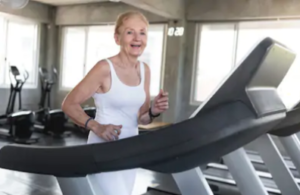
Shutterstock/Credit: This Is Me
The first inclination for many new users of a treadmill, particularly elderly people, is to cling onto the front bar or side bars.
But think about what this really means: mimicking using a walker.
If you’re able bodied (don’t rely on a cane or walker), but then step onto a treadmill and hold on during your walking session, you are performing BELOW baseline walking ability. This will downgrade you, not upgrade you.
In the activities of daily living, a person with chronic heart failure but without mobility handicap will not hold onto anything for support while walking from point A to point B.
Sure, he or she may pause to catch their breath here and there, but actual mobility is not impaired. Hence, there is no need to hold onto a treadmill.
To hold onto a treadmill means to regress your ability to balance and to “unteach” your body in efficient walking.
Start out at a slow speed. It’s amazing how many older people will put a treadmill at its highest incline and the speed at a fast clip, then hold on tight and claim they’ll fall off if they don’t.
Use a zero or small incline and a SLOW speed, and do NOT hold on.
This is the only way to resemble actual walking.
Holding on can lead to repetitive stress injuries in the hips and shoulders, and can lead to forward posture.
Gradually build up your confidence by increasing the speed in small increments over time.
An arm swing burns more calories and is the natural way to walk — and this rule applies to people with low ejection fractions or chronic heart failure who want to employ exercise therapy.

Having performed over 4,000 coronary angiograms and angioplasties, Dr. Lepor has focused on prevention and treatment of coronary heart disease.
 Lorra Garrick has been covering medical, fitness and cybersecurity topics for many years, having written thousands of articles for print magazines and websites, including as a ghostwriter. She’s also a former ACE-certified personal trainer.
Lorra Garrick has been covering medical, fitness and cybersecurity topics for many years, having written thousands of articles for print magazines and websites, including as a ghostwriter. She’s also a former ACE-certified personal trainer.
.
Top image: Freepik.com/yanalya
How Much Will Mild Chronic Heart Failure Affect Exercise?
Suppose a person has been exercising for years, but then gradually develops chronic heart failure.
How noticeable or rapid will the decline be in this person’s ability to exercise?
“The decline in function will depend on the pace and severity of the process that leads to a weak heart,” explains Norman E. Lepor, MD, cardiologist and internal medicine specialist Norman E. Lepor, MD, who’s with Cedars Sinai in Beverly Hills, CA.
“Generally a patient with good cardiovascular fitness will tolerate a given amount of cardiac dysfunction than one who is in poor shape.”
What this means is that if we have two people, “A” and “B,” and “A” has been doing aerobic exercise for years, while “B” has been completely sedentary…then if both people begin developing congestive heart failure, it will be better tolerated in “A.”
Nevertheless, congestive heart failure would over time start manifesting itself to “A.”
Where will the uncharacteristic fatigue be most noticeable?
“Walking rapidly or on inclines,” says Dr. Lepor.
The progression of exercise-performance declination will be more rapid than what would normally occur from the aging process.
For example, suppose a woman has been hiking for many years, continuing to do this into her 60s and 70s.
But we can’t expect her to be as efficient in her 80s as she was in her 70s—simply due to the aging process.
There will be a natural decline in her cardiorespiratory efficacy—and she’ll notice that hiking the same mountain—the one she’s done for years—takes a bit longer, and/or requires more frequent or longer rests.
But the decline in cardiorespiratory fitness, from congestive heart failure, could also be subtle, says Dr. Lepor. It can be subtle enough to be misdiagnosed as asthma or chronic obstructive pulmonary disease, he says.
It will help to be very aware of exercise performance and capacity, and to note when you take time off from cardio exercise (due to foot injury, travel, schedule conflicts, the flu or some other non-cardiac reason).
After all, skipping aerobic workouts will result in a decline in cardiovascular function; this decline happens faster in older people.
However…the absence of congestive or chronic heart failure means that the older jogger, hiker, cyclist, hill-dasher, runner, etc., will bounce back and recover their previous stamina rather quickly (assuming that they haven’t missed so many training sessions that they’ve lost significant fitness).

Having performed over 4,000 coronary angiograms and angioplasties, Dr. Lepor has focused on prevention and treatment of coronary heart disease.
 Lorra Garrick has been covering medical, fitness and cybersecurity topics for many years, having written thousands of articles for print magazines and websites, including as a ghostwriter. She’s also a former ACE-certified personal trainer.
Lorra Garrick has been covering medical, fitness and cybersecurity topics for many years, having written thousands of articles for print magazines and websites, including as a ghostwriter. She’s also a former ACE-certified personal trainer.
.
Top image: Freepik.com, pressfoto
How Low Can Ejection Fraction Be without Congestive HF?
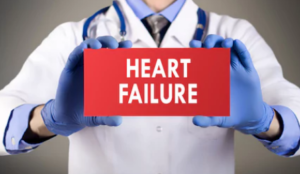
Is it possible to have a really low ejection fraction and still not have congestive heart failure?
“There are two major types of congestive heart failure (CHF),” begins Norman E. Lepor, MD, cardiologist and internal medicine specialist Norman E. Lepor, MD, who’s with Cedars Sinai in Beverly Hills, CA.
“Half of the patients with heart failure symptoms that include shortness of breath with exertion, easy fatigue, a decrease in exercise tolerance and lower extremity fluid accumulation (edema) have what we call preserved or normal ejection fraction due to stiff and thickened ventricular walls.
“This condition is seen in patients who have poorly treated chronic hypertension [high blood pressure] and/or coronary artery disease.
“The other half of patients with heart failure have abnormal ejection fractions or what is called systolic dysfunction.
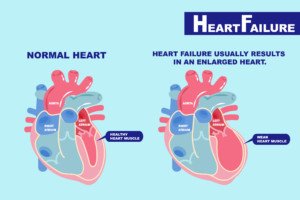
Shutterstock/EstherQueen999
“There is wide variance in the threshold of ejection fractions in these types of heart failure patients, but one could expect symptoms to occur when the ejection fraction is less than 40 percent.”
How does patient’s level of fitness factor into this?
Dr. Lepor explains, “Fitness plays a pivotal role in developing symptoms of heart failure.
“In patients who exercise regularly and maintain good fitness, have muscles that are more efficient and need less oxygen and nutrition to function.
“Therefore the better fit one is, the less symptoms such as easy fatigue or exercise intolerance they would have at any level of ejection fraction reduction.”

Having performed over 4,000 coronary angiograms and angioplasties, Dr. Lepor has focused on prevention and treatment of coronary heart disease.
 Lorra Garrick has been covering medical, fitness and cybersecurity topics for many years, having written thousands of articles for print magazines and websites, including as a ghostwriter. She’s also a former ACE-certified personal trainer.
Lorra Garrick has been covering medical, fitness and cybersecurity topics for many years, having written thousands of articles for print magazines and websites, including as a ghostwriter. She’s also a former ACE-certified personal trainer.
.
Top image: Shutterstock/Green Apple
Can Heart Problems Cause Sudden Weight Gain?
The kind of weight gain that heart problems can cause is not the same that’s caused by eating too much.
In fact, weight gain from chronic heart failure has absolutely nothing to do with body fat.
“Heart failure can lead to weight gain due to fluid retention most likely seen in the lower extremities, though much fluid can accumulate in the abdomen as ascites or in the chest as pleural effusions,” says cardiologist and internal medicine specialist Norman E. Lepor, MD, who’s with Cedars Sinai in Beverly Hills, CA.
In the lower extremities, the weight gain presents as swelling around the ankles and lower legs.
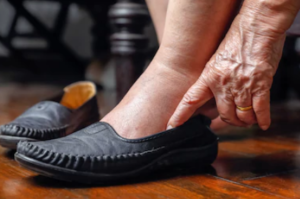
Shutterstock/Toa55
This fluid retention can extend higher up in the legs and affect the groin area.
A person with chronic heart failure (formerly more commonly referred to as “congestive” heart failure) can gain five pounds of fluid weight in a single night.
This is why people with chronic heart failure are instructed to weigh themselves first thing every morning — and never skip a morning.
Why this Heart Problem Causes Sudden Weight Gain
Though fluid retention can be caused by a variety of illnesses, chronic heart failure is a very common cause.
Fluid in the lungs is called a pleural effusion, and this will show up on a CT scan or X-ray.
Dr. Lepor says that this fluid retention in heart failure patients is treated with diuretics and salt (sodium) restriction.
The diuretics, such as Lasix, treat the symptom, not the underlying disease process.
Another name for the fluid retention or “swelling” is edema.
The fluid can cause, for instance, an increase of eight pounds over a period of just several days — despite the patient not changing their eating habits.
Men and women with chronic heart failure are urged to also document their weight every morning to see if there’s any unexplained weight gain from week to week, not just day to day.
Not all people with chronic heart failure develop the edema in their lower extremities.
For some, the sudden weight gain could be in their abdomen (ascites; pronounced uh-sight-eez) or the pleural effusion (excess fluid around the lungs).

Having performed over 4,000 coronary angiograms and angioplasties, Dr. Lepor has focused on prevention and treatment of coronary heart disease.
 Lorra Garrick has been covering medical, fitness and cybersecurity topics for many years, having written thousands of articles for print magazines and websites, including as a ghostwriter. She’s also a former ACE-certified personal trainer.
Lorra Garrick has been covering medical, fitness and cybersecurity topics for many years, having written thousands of articles for print magazines and websites, including as a ghostwriter. She’s also a former ACE-certified personal trainer.
.
Top image: Shutterstock/Rocketclips, Inc.
Can Heart Bypass Surgery Prevent Congestive Heart Failure?

Are you wondering if coronary bypass surgery, aka CABG, can prevent the development of chronic heart failure?
- Heart failure may involve fluid buildup in the legs that needs to be controlled with medication.
- In other cases there is not an issue of fluid buildup, but the patient still needs to take great care to manage the condition.
Coronary Bypass Surgery Preventing Chronic Heart Failure?
“CABG and percutaneous interventions (angioplasty) can in some cases [sic] to preventing CHF in patients who have severe blockages in their coronary arteries that severely reduce blood flow and the delivery of oxygen and nutrition to heart cells by increasing blood flow,” explains Norman E. Lepor, MD, cardiologist and internal medicine specialist Norman E. Lepor, MD, who’s with Cedars Sinai in Beverly Hills, CA.
Why can’t CABG prevent congestive heart failure in ALL the patients who undergo this heart procedure?
Dr. Lepor explains, “Patients who do not seem to benefit from CABG or angioplasties to prevent CHF include those with milder disease (fewer blockages, blockages that are not in critical areas such as the ‘widow maker’ and less severe blockages.”
The widow maker refers to the left main artery in the heart, which supplies the left anterior descending (LAD) artery and left circumflex artery. Sometimes, however, this term refers only to the LAD.
If a blockage occurs to the left main artery, a significant portion of heart muscle will be left without oxygen.
If not treated promptly, a victim can suffer a quick death.
Other Ways to Help Prevent Chronic Heart Failure from Developing
How often do you check your blood pressure? High blood pressure is a big risk factor for the development of chronic heart failure.
Ideally, you should check your blood pressure at least once a week, or as advised by your healthcare provider.
Consistent tracking helps manage and reduce the risk of developing chronic heart failure.
Do you smoke? Then quit. Yes, it should be that easy for anyone who knows just how dangerous tobacco is.
While quitting can be challenging, there are many resources available to help, such as support groups, medications and counseling.
It’s important to remember that every attempt to quit is a step towards better health.
Seeking professional advice can provide additional strategies and support.
Do you exercise? No, not housework or walking the poodle, but REAL exercise: structured aerobics and strength training workouts. Get moving.
These three tactics not only fight off chronic heart failure but they also help prevent the need for coronary bypass surgery.

Having performed over 4,000 coronary angiograms and angioplasties, Dr. Lepor has focused on prevention and treatment of coronary heart disease.
 Lorra Garrick has been covering medical, fitness and cybersecurity topics for many years, having written thousands of articles for print magazines and websites, including as a ghostwriter. She’s also a former ACE-certified personal trainer.
Lorra Garrick has been covering medical, fitness and cybersecurity topics for many years, having written thousands of articles for print magazines and websites, including as a ghostwriter. She’s also a former ACE-certified personal trainer.
.

